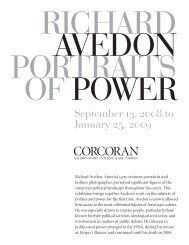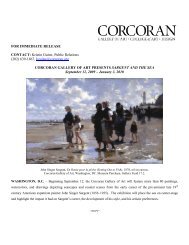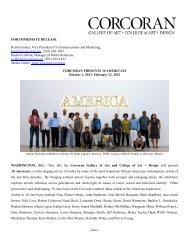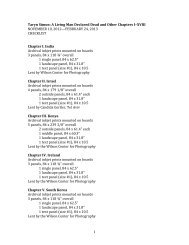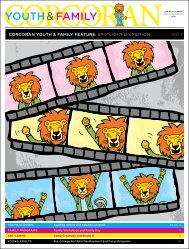Aaron Douglas, Into Bondage, 1936 - Corcoran Gallery of Art
Aaron Douglas, Into Bondage, 1936 - Corcoran Gallery of Art
Aaron Douglas, Into Bondage, 1936 - Corcoran Gallery of Art
Create successful ePaper yourself
Turn your PDF publications into a flip-book with our unique Google optimized e-Paper software.
Sam Gilliam (born Tupelo, MS, 1933–lives and works in Washington, D.C.)<br />
Blue Twirl, 1971<br />
Acrylic on canvas, 72 x 72 x 2 1/2 in. (182.88 x 182.88 x 6.4 cm)<br />
Gift <strong>of</strong> the Women’s Committee <strong>of</strong> the <strong>Corcoran</strong> <strong>Gallery</strong> <strong>of</strong> <strong>Art</strong>, 1972<br />
© Sam Gilliam<br />
About the <strong>Art</strong>ist<br />
Sam Gilliam, a prominent Washington, D. C. artist, was born<br />
in Tupelo, Mississippi and grew up in Louisville, Kentucky. Gilliam<br />
received both his B.A. in fine arts and his M.F.A. in painting from<br />
the University <strong>of</strong> Louisville, where he created paintings similar to<br />
those associated with California’s Bay Area Figurative Movement.<br />
He moved to D.C. in 1962, around the time that artists associated<br />
with the Washington Color School were attracting national attention.<br />
Interested in the tools and techniques <strong>of</strong> his new colleagues, Gilliam<br />
began to experiment with unprimed canvas and Magna acrylic<br />
resin paints. He attained his first signature style <strong>of</strong> abstract painting<br />
in the late 1960s by pouring, dripping, and splashing acrylic pigment<br />
directly onto unprimed canvas. Gilliam eventually departed from<br />
the traditional practice <strong>of</strong> painting on two-dimensional canvases<br />
stretched over wooden bars. These unstretched canvases explored<br />
the intersection <strong>of</strong> painting, sculpture, and architecture. Gilliam<br />
remains committed to investigating paint as a medium with diverse<br />
potential. He has taught in D.C. public schools and at several<br />
colleges and universities—including the <strong>Corcoran</strong> School <strong>of</strong> <strong>Art</strong>—<br />
and continues to influence generations <strong>of</strong> younger artists who regard<br />
paint as a material to which they can give shape and volume.<br />
About the <strong>Art</strong><br />
To make Blue Twirl, part <strong>of</strong> Gilliam’s early signature “slice” series,<br />
the artist dripped and poured paint onto a six-foot-square<br />
unprimed canvas. He began by soaking and splattering the<br />
lightest colors <strong>of</strong> the composition, keeping in mind the spaces<br />
he wanted to leave devoid <strong>of</strong> color. Gilliam then applied the darker<br />
hues, glazing over the lighter layers—the pigments’ absorption<br />
aided by a chemical substance called water tension breaker.<br />
The still-wet canvas was then folded back and forth on itself<br />
and left to dry in a heap on the floor. While the work was still<br />
in a pile, Gilliam applied paint to the exposed surface area in order<br />
to create texture and highlight the composition in ways that became<br />
apparent only later, when the work was spread out and examined.<br />
When the paint had dried and Gilliam unfurled the canvas, the<br />
creases translated into lines and swirls and the pools <strong>of</strong> paint<br />
became organic patterns that straddled those lines. Blue Twirl’s<br />
beveled edge adds to the impression that the painting is emerging<br />
from the wall as a living, breathing object <strong>of</strong> weight and substance.<br />
This work and other slice paintings represented a departure from<br />
the geometric imagery and hard edges <strong>of</strong> other Washington Color<br />
School works.<br />
Suggested Dialogue<br />
• How do you feel when you look at Gilliam’s canvas, Blue Twirl?<br />
What mood do you think it best represents?<br />
• To where is your eye drawn first? Can you find a focal point on<br />
the canvas? What kind <strong>of</strong> lines do you see? Describe the shapes.<br />
• What did Gilliam do first to begin this work? How do you think<br />
he decided when the painting was finished?<br />
• Where do you see “hard edges” <strong>of</strong> paint? Where are the s<strong>of</strong>ter<br />
areas <strong>of</strong> color?<br />
• Can you imagine the process through which Gilliam created<br />
Blue Twirl?<br />
Extended Dialogue<br />
• What words would you chose to explain Blue Twirl to someone<br />
who hasn’t seen the image?<br />
• How does Gilliam’s manner <strong>of</strong> abstract painting differ from that<br />
<strong>of</strong> Alma Thomas? If you wanted to create an abstract work <strong>of</strong> art,<br />
which style would you choose?<br />
• Many artists, including Sam Gilliam, are influenced by music.<br />
Do you think Gilliam might have been listening to music when<br />
he created Blue Twirl? If so, what type <strong>of</strong> music?<br />
Vocabulary<br />
Bay Area Figurative Movement:<br />
A mid-20th century art movement made<br />
up <strong>of</strong> a group <strong>of</strong> artists in the San Francisco<br />
Bay Area who abandoned working in the<br />
prevailing style <strong>of</strong> Abstract Expressionism<br />
in favor <strong>of</strong> a return to figuration in painting<br />
during the 1950s and onward into the 1960s.<br />
Washington Color School: A loosely<br />
affiliated group <strong>of</strong> color field artist<br />
centered in Washington D.C. who,<br />
from the mid-1950s, explored geometric<br />
formality and the expressive qualities<br />
<strong>of</strong> color—<strong>of</strong>ten in large-scale paintings.<br />
Magna: The world’s first artist acrylic paint<br />
was developed in 1947. Magna can be<br />
mixed with turpentine or mineral spirits.<br />
Water tension breaker: A substance<br />
mixed into water-based paints in order<br />
to facilitate the pigments’ absorption into<br />
the canvas.<br />
Color Field paintings: A type <strong>of</strong> painting<br />
which evolved in the United States in the<br />
mid-1950s and continued until the late<br />
1960s. Fields <strong>of</strong> color were applied in an<br />
abstract manner across the canvas, which<br />
was regarded as a two-dimensional plane:<br />
conventional pictorial depth and gestural<br />
brushwork were rejected.<br />
Abstract Expressionism: The movement<br />
in American painting, centered mainly<br />
in New York, that flourished in the 1940s<br />
and 1950s. Styles ranged from spontaneous,<br />
gestural compositions that paid attention<br />
to the qualities <strong>of</strong> the painting materials<br />
and stood as records <strong>of</strong> the painting<br />
process, to contemplative, near monochromatic<br />
works featuring large areas<br />
<strong>of</strong> color.<br />
Support for <strong>Art</strong>s 101 materials is made possible in part by the Women’s Committee <strong>of</strong> the <strong>Corcoran</strong> and the DC Commission on the <strong>Art</strong>s and Humanities.


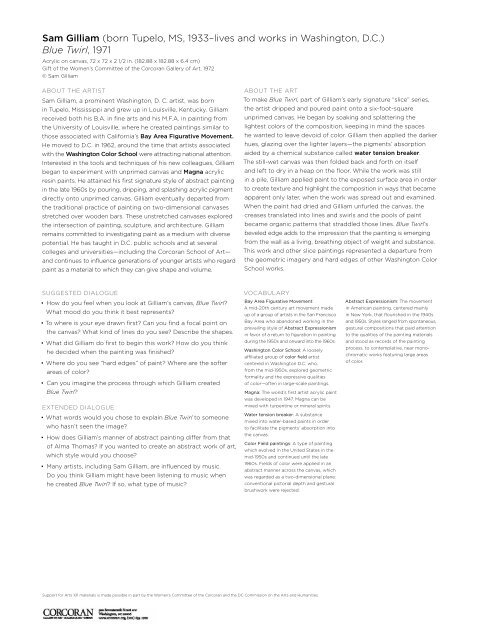
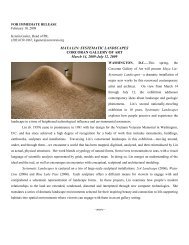
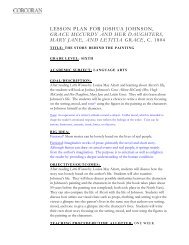
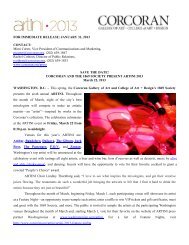


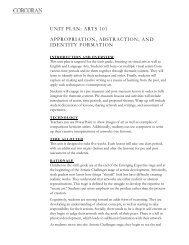
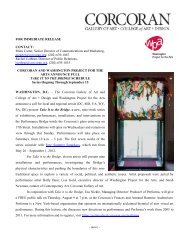

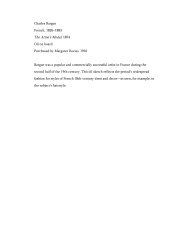
![[PDF] Ellen Harvey: The Alien's Guide to the Ruins of Washington, DC](https://img.yumpu.com/32942537/1/190x190/pdf-ellen-harvey-the-aliens-guide-to-the-ruins-of-washington-dc.jpg?quality=85)
